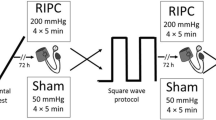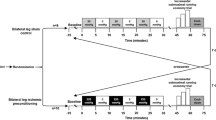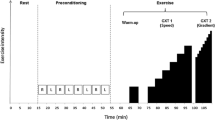Abstract
Acute limb ischemia induced by pressure cuffs before activity (ischemic preconditioning; IPC) has been reported to improve exercise performance at maximal efforts. The purpose of this investigation was to determine the effects of IPC during a submaximal performance test in competitive amateur level cyclists. Twelve healthy, male cyclists participated in two performance tests in which they cycled at successive relative intensities of 30, 50, and 70% of their maximal power output for 5 min each. The test culminated with an intensity of 90% of their maximal power output until exhaustion. Prior to each test, subjects randomly completed a control (CON) or IPC treatment. The IPC treatment consisted of alternating 220 mmHg of pressure applied by a cuff to the proximal portion of both thighs for 3, 5 min bouts separated by 5 min of rest. In addition to performance time to exhaustion, variables associated with aerobic performance (oxygen consumption, ventilation, respiratory exchange ratio, heart rate, and blood lactate) were measured continuously throughout the performance test. Statistical comparisons of data were made with repeated measures analyses of variance or paired T tests and significance was accepted as P < 0.05. Heart rate at the 30% relative intensity was significantly higher for the IPC treatment, but there were no other statistically significant differences between the control and IPC treatments across all variables and relative intensities. In this group of competitive amateur-level cyclists, an acute treatment of IPC did not improve performance at each submaximal intensity or increase time to exhaustion.

Similar content being viewed by others
References
Abe T, Kearns CF, Sato Y (2006) Muscle size and strength are increased following walk training with restricted venous blood flow from the leg muscle, Kaatsu-walk training. J Appl Physiol 100:1460–1466
Andreas M, Schmid AI, Keilani M, Doberer D, Bartko J, Crevenna R, Moser E, Wolzt M (2011) Effect of ischemic preconditioning in skeletal muscle measured by functional magnetic resonance imaging and spectroscopy: a randomized crossover trial. J Cardiovasc Magn Reson 13:32
Carini R, De Cesaris M, SPlendore R, Bagnati M, Albano E (2000) Ischemic preconditioning reduces Na(+) accumulation and cell killing in isolated rat hepatocytes exposed to hypoxia. Hepatology 31(1):166–172
De Groot P, Thijssen D, Sanchez M, Ellenkamp R, Hopman M (2010) Ischemic preconditioning improves maximal performance in humans. Eur J Appl Physiol 108:141–146
Dempsey J, Wagner P (1999) Exercise-induced arterial hypoxemia. J Appl Physiol 87:1997–2006
Garlid K, Dos S, Xie Z, Costa A, Paucek P (2003) Mitochondrial potassium transport: the role of the mitochondrial ATP-sensitive K(+) channel in cardiac function and cardioprotection. Biochim Biophys Acta 1606(1–3):1–21
Haljamae H, Enger E (1975) Human skeletal muscle energy metabolism during and after complete tourniquet ischemia. Ann Surg 1:9–14
Hansen E, Jensen K, Pedersen P (2006) Performance following prolonged sub-maximal cycling at optimal versus freely chosen pedal rate. Eur J Appl Physiol 98:227–233
Hickner R, Dyck D, Sklar J, Hatley H, Byrd P (2010) Effect of 28 days of creatine ingestion on muscle metabolism and performance of a simulated cycling road race. J Int Soc Sports Nutr 7:26
Iida H, Kurano M, Takano H, Kubota N, Morita T, Meguro K, Sato Y, Abe T, Yamazaki Y, Uno K, Takenaka K, Hirose K, Nakajima T (2007) Hemodynamic and neurohumoral responses to the restriction of femoral blood flow by KAATSU in healthy subjects. Eur J Appl Physiol 100:275–285
Jean-St-Michel E, Manlhiot C, Li J, Tropak M, Michelsen M, Schmidt M, McCrindle B, Wells G, Redington A (2011) Remote preconditioning improves maximal performance in highly trained athletes. Med Sci Sports Exerc 43(7):1280–1286
Lawson CS, Downey JM (1993) Preconditioning: state of the art myocardial protection. Cardiovasc Res 27:542–550
Mujika I, Padilla S (2000) Detraining: loss of training-induced physiological and performance adaptations. Part I: short term insufficient training stimulus. Sports Med 30(2):79–87
Murry CE, Jennings RB, Reimer KA (1986) Preconditioning with ischemia: a delay of lethal cell injury in ischemic myocardium. Circulation 74:1124–1136
Pang C, Yang R, Zhong A, Xu N, Body B, Forrest C (1995) Acute ischaemic preconditioning protects against skeletal muscle infarction in the pig. Cardiovasc Res 29(6):782–788
Park S, Kim J, Choi H, Kim H, Beekley M, Nho H (2010) Increase in maximal oxygen uptake following 2-week walk training with blood flow occlusion in athletes. Eur J Appl Physiol 109:591–600
Pasupathy S, Homer-Vanniasinkam S (2005) Ischaemic preconditioning protects against ischaemia/reperfusion injury: emerging concepts. Eur J Vasc Endovasc Surg 29:106–115
Shaw JA, Murray DG (1982) The relationship between tourniquet pressure and underlying soft-tissue pressure in the thigh. J Bone and Joint Surg Am 64:1148–1152
Acknowledgments
The authors would like to thank the Ohio Musculoskeletal & Neurological Institute (OMNI) for providing equipment support.
Conflict of interest
The authors have no conflict of interest.
Author information
Authors and Affiliations
Corresponding author
Additional information
Communicated by William J. Kraemer.
Rights and permissions
About this article
Cite this article
Clevidence, M.W., Mowery, R.E. & Kushnick, M.R. The effects of ischemic preconditioning on aerobic and anaerobic variables associated with submaximal cycling performance. Eur J Appl Physiol 112, 3649–3654 (2012). https://doi.org/10.1007/s00421-012-2345-5
Received:
Accepted:
Published:
Issue Date:
DOI: https://doi.org/10.1007/s00421-012-2345-5




